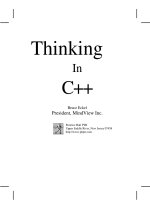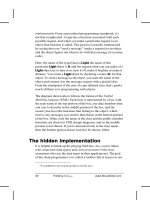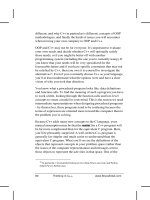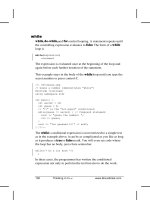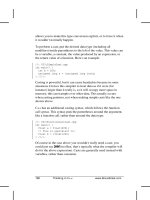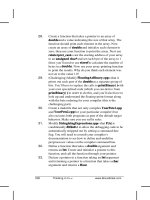Thinking in C plus plu (P5) pptx
Bạn đang xem bản rút gọn của tài liệu. Xem và tải ngay bản đầy đủ của tài liệu tại đây (144.24 KB, 50 trang )
180 Thinking in C++ www.BruceEckel.com
allows you to make this type conversion explicit, or to force it when
it wouldn’t normally happen.
To perform a cast, put the desired data type (including all
modifiers) inside parentheses to the left of the value. This value can
be a variable, a constant, the value produced by an expression, or
the return value of a function. Here’s an example:
//: C03:SimpleCast.cpp
int main() {
int b = 200;
unsigned long a = (unsigned long int)b;
} ///:~
Casting is powerful, but it can cause headaches because in some
situations it forces the compiler to treat data as if it were (for
instance) larger than it really is, so it will occupy more space in
memory; this can trample over other data. This usually occurs
when casting pointers, not when making simple casts like the one
shown above.
C++ has an additional casting syntax, which follows the function
call syntax. This syntax puts the parentheses around the argument,
like a function call, rather than around the data type:
//: C03:FunctionCallCast.cpp
int main() {
float a = float(200);
// This is equivalent to:
float b = (float)200;
} ///:~
Of course in the case above you wouldn’t really need a cast; you
could just say
200f
(in effect, that’s typically what the compiler will
do for the above expression). Casts are generally used instead with
variables, rather than constants.
3: The C in C++ 181
C++ explicit casts
Casts should be used carefully, because what you are actually
doing is saying to the compiler “Forget type checking – treat it as
this other type instead.” That is, you’re introducing a hole in the
C++ type system and preventing the compiler from telling you that
you’re doing something wrong with a type. What’s worse, the
compiler believes you implicitly and doesn’t perform any other
checking to catch errors. Once you start casting, you open yourself
up for all kinds of problems. In fact, any program that uses a lot of
casts should be viewed with suspicion, no matter how much you
are told it simply “must” be done that way. In general, casts should
be few and isolated to the solution of very specific problems.
Once you understand this and are presented with a buggy
program, your first inclination may be to look for casts as culprits.
But how do you locate C-style casts? They are simply type names
inside of parentheses, and if you start hunting for such things you’ll
discover that it’s often hard to distinguish them from the rest of
your code.
Standard C++ includes an explicit cast syntax that can be used to
completely replace the old C-style casts (of course, C-style casts
cannot be outlawed without breaking code, but compiler writers
could easily flag old-style casts for you). The explicit cast syntax is
such that you can easily find them, as you can see by their names:
static_cast
For “well-behaved” and
“reasonably well-behaved” casts,
including things you might now
do without a cast (such as an
automatic type conversion).
const_cast
To cast away
const
and/or
volatile
.
reinterpret_cast
To cast to a completely different
meanin
g
. The ke
y
is that
y
ou’ll
182 Thinking in C++ www.BruceEckel.com
need to cast back to the original
type to use it safely. The type you
cast to is typically used only for
bit twiddling or some other
mysterious purpose. This is the
most dangerous of all the casts.
dynamic_cast
For type-safe downcasting (this
cast will be described in Chapter
15).
The first three explicit casts will be described more completely in
the following sections, while the last one can be demonstrated only
after you’ve learned more, in Chapter 15.
static_cast
A
static_cast
is used for all conversions that are well-defined. These
include “safe” conversions that the compiler would allow you to do
without a cast and less-safe conversions that are nonetheless well-
defined. The types of conversions covered by
static_cast
include
typical castless conversions, narrowing (information-losing)
conversions, forcing a conversion from a
void*
, implicit type
conversions, and static navigation of class hierarchies (since you
haven’t seen classes and inheritance yet, this last topic will be
delayed until Chapter 15):
//: C03:static_cast.cpp
void func(int) {}
int main() {
int i = 0x7fff; // Max pos value = 32767
long l;
float f;
// (1) Typical castless conversions:
l = i;
f = i;
// Also works:
l = static_cast<long>(i);
f = static_cast<float>(i);
3: The C in C++ 183
// (2) Narrowing conversions:
i = l; // May lose digits
i = f; // May lose info
// Says "I know," eliminates warnings:
i = static_cast<int>(l);
i = static_cast<int>(f);
char c = static_cast<char>(i);
// (3) Forcing a conversion from void* :
void* vp = &i;
// Old way produces a dangerous conversion:
float* fp = (float*)vp;
// The new way is equally dangerous:
fp = static_cast<float*>(vp);
// (4) Implicit type conversions, normally
// performed by the compiler:
double d = 0.0;
int x = d; // Automatic type conversion
x = static_cast<int>(d); // More explicit
func(d); // Automatic type conversion
func(static_cast<int>(d)); // More explicit
} ///:~
In Section (1), you see the kinds of conversions you’re used to
doing in C, with or without a cast. Promoting from an
int
to a
long
or
float
is not a problem because the latter can always hold every
value that an
int
can contain. Although it’s unnecessary, you can
use
static_cast
to highlight these promotions.
Converting back the other way is shown in (2). Here, you can lose
data because an
int
is not as “wide” as a
long
or a
float
; it won’t
hold numbers of the same size. Thus these are called
narrowing
conversions
. The compiler will still perform these, but will often give
you a warning. You can eliminate this warning and indicate that
you really did mean it using a cast.
Assigning from a
void*
is not allowed without a cast in C++ (unlike
C), as seen in (3). This is dangerous and requires that programmers
184 Thinking in C++ www.BruceEckel.com
know what they’re doing. The
static_cast
, at least, is easier to locate
than the old standard cast when you’re hunting for bugs.
Section (4) of the program shows the kinds of implicit type
conversions that are normally performed automatically by the
compiler. These are automatic and require no casting, but again
static_cast
highlights the action in case you want to make it clear
what’s happening or hunt for it later.
const_cast
If you want to convert from a
const
to a non
const
or from a
volatile
to a non
volatile
, you use
const_cast
. This is the
only
conversion
allowed with
const_cast
; if any other conversion is involved it must
be done using a separate expression or you’ll get a compile-time
error.
//: C03:const_cast.cpp
int main() {
const int i = 0;
int* j = (int*)&i; // Deprecated form
j = const_cast<int*>(&i); // Preferred
// Can't do simultaneous additional casting:
//! long* l = const_cast<long*>(&i); // Error
volatile int k = 0;
int* u = const_cast<int*>(&k);
} ///:~
If you take the address of a
const
object, you produce a pointer to a
const
, and this cannot be assigned to a non
const
pointer without a
cast. The old-style cast will accomplish this, but the
const_cast
is
the appropriate one to use. The same holds true for
volatile
.
reinterpret_cast
This is the least safe of the casting mechanisms, and the one most
likely to produce bugs. A
reinterpret_cast
pretends that an object is
just a bit pattern that can be treated (for some dark purpose) as if it
were an entirely different type of object. This is the low-level bit
twiddling that C is notorious for. You’ll virtually always need to
3: The C in C++ 185
reinterpret_cast
back to the original type (or otherwise treat the
variable as its original type) before doing anything else with it.
//: C03:reinterpret_cast.cpp
#include <iostream>
using namespace std;
const int sz = 100;
struct X { int a[sz]; };
void print(X* x) {
for(int i = 0; i < sz; i++)
cout << x->a[i] << ' ';
cout << endl << " " << endl;
}
int main() {
X x;
print(&x);
int* xp = reinterpret_cast<int*>(&x);
for(int* i = xp; i < xp + sz; i++)
*i = 0;
// Can't use xp as an X* at this point
// unless you cast it back:
print(reinterpret_cast<X*>(xp));
// In this example, you can also just use
// the original identifier:
print(&x);
} ///:~
In this simple example,
struct X
just contains an array of
int
, but
when you create one on the stack as in
X x
, the values of each of the
int
s are garbage (this is shown using the
print( )
function to display
the contents of the
struct
). To initialize them, the address of the
X
is
taken and cast to an
int
pointer, which is then walked through the
array to set each
int
to zero. Notice how the upper bound for
i
is
calculated by “adding”
sz
to
xp
; the compiler knows that you
actually want
sz
pointer locations greater than
xp
and it does the
correct pointer arithmetic for you.
The idea of
reinterpret_cast
is that when you use it, what you get is
so foreign that it cannot be used for the type’s original purpose
186 Thinking in C++ www.BruceEckel.com
unless you cast it back. Here, we see the cast back to an
X*
in the
call to print, but of course since you still have the original identifier
you can also use that. But the
xp
is only useful as an
int*
, which is
truly a “reinterpretation” of the original
X
.
A
reinterpret_cast
often indicates inadvisable and/or nonportable
programming, but it’s available when you decide you have to use
it.
sizeof – an operator by itself
The
sizeof
operator stands alone because it satisfies an unusual
need.
sizeof
gives you information about the amount of memory
allocated for data items. As described earlier in this chapter,
sizeof
tells you the number of bytes used by any particular variable. It can
also give the size of a data type (with no variable name):
//: C03:sizeof.cpp
#include <iostream>
using namespace std;
int main() {
cout << "sizeof(double) = " << sizeof(double);
cout << ", sizeof(char) = " << sizeof(char);
} ///:~
By definition, the
sizeof
any type of
char
(
signed
,
unsigned
or
plain) is always one, regardless of whether the underlying storage
for a
char
is actually one byte. For all other types, the result is the
size in bytes.
Note that
sizeof
is an operator, not a function. If you apply it to a
type, it must be used with the parenthesized form shown above,
but if you apply it to a variable you can use it without parentheses:
//: C03:sizeofOperator.cpp
int main() {
int x;
int i = sizeof x;
} ///:~
3: The C in C++ 187
sizeof
can also give you the sizes of user-defined data types. This is
used later in the book.
The asm keyword
This is an escape mechanism that allows you to write assembly
code for your hardware within a C++ program. Often you’re able
to reference C++ variables within the assembly code, which means
you can easily communicate with your C++ code and limit the
assembly code to that necessary for efficiency tuning or to use
special processor instructions. The exact syntax that you must use
when writing the assembly language is compiler-dependent and
can be discovered in your compiler’s documentation.
Explicit operators
These are keywords for bitwise and logical operators. Non-U.S.
programmers without keyboard characters like
&
,
|
,
^
, and so on,
were forced to use C’s horrible
trigraphs
, which were not only
annoying to type, but obscure when reading. This is repaired in
C++ with additional keywords:
Keyword Meaning
and
&&
(logical
and
)
or
||
(logical
or
)
not
!
(logical NOT)
not_eq
!=
(logical not-equivalent)
bitand
&
(bitwise
and
)
and_eq
&=
(bitwise
and
-assignment)
bitor
|
(bitwise
or
)
or_eq
|=
(bitwise or-assignment)
xor
^
(bitwise exclusive-or)
188 Thinking in C++ www.BruceEckel.com
Keyword Meaning
xor_eq
^=
(bitwise exclusive-or-
assignment)
compl
~
(ones complement)
If your compiler complies with Standard C++, it will support these
keywords.
Composite type creation
The fundamental data types and their variations are essential, but
rather primitive. C and C++ provide tools that allow you to
compose more sophisticated data types from the fundamental data
types. As you’ll see, the most important of these is
struct
, which is
the foundation for
class
in C++. However, the simplest way to
create more sophisticated types is simply to alias a name to another
name via
typedef
.
Aliasing names with typedef
This keyword promises more than it delivers:
typedef
suggests
“type definition” when “alias” would probably have been a more
accurate description, since that’s what it really does. The syntax is:
typedef existing-type-description alias-name
People often use
typedef
when data types get slightly complicated,
just to prevent extra keystrokes. Here is a commonly-used
typedef
:
typedef unsigned long ulong;
Now if you say
ulong
the compiler knows that you mean
unsigned
long
. You might think that this could as easily be accomplished
using preprocessor substitution, but there are key situations in
which the compiler must be aware that you’re treating a name as if
it were a type, so
typedef
is essential.
3: The C in C++ 189
One place where
typedef
comes in handy is for pointer types. As
previously mentioned, if you say:
int* x, y;
This actually produces an
int*
which is
x
and an
int
(not an
int*
)
which is
y
. That is, the ‘
*
’ binds to the right, not the left. However,
if you use a
typedef
:
typedef int* IntPtr;
IntPtr x, y;
Then both
x
and
y
are of type
int*
.
You can argue that it’s more explicit and therefore more readable to
avoid
typedef
s for primitive types, and indeed programs rapidly
become difficult to read when many
typedef
s are used. However,
typedef
s become especially important in C when used with
struct
.
Combining variables with struct
A
struct
is a way to collect a group of variables into a structure.
Once you create a
struct
, then you can make many instances of this
“new” type of variable you’ve invented. For example:
//: C03:SimpleStruct.cpp
struct Structure1 {
char c;
int i;
float f;
double d;
};
int main() {
struct Structure1 s1, s2;
s1.c = 'a'; // Select an element using a '.'
s1.i = 1;
s1.f = 3.14;
s1.d = 0.00093;
s2.c = 'a';
s2.i = 1;
s2.f = 3.14;
190 Thinking in C++ www.BruceEckel.com
s2.d = 0.00093;
} ///:~
The
struct
declaration must end with a semicolon. In
main( )
, two
instances of
Structure1
are created:
s1
and
s2
. Each of these has
their own separate versions of
c
,
i
,
f
, and
d
. So
s1
and
s2
represent
clumps of completely independent variables. To select one of the
elements within
s1
or
s2
, you use a ‘
.
’, syntax you’ve seen in the
previous chapter when using C++
class
objects – since
class
es
evolved from
struct
s, this is where that syntax arose from.
One thing you’ll notice is the awkwardness of the use of
Structure1
(as it turns out, this is only required by C, not C++). In C, you can’t
just say
Structure1
when you’re defining variables, you must say
struct Structure1
. This is where
typedef
becomes especially handy
in C:
//: C03:SimpleStruct2.cpp
// Using typedef with struct
typedef struct {
char c;
int i;
float f;
double d;
} Structure2;
int main() {
Structure2 s1, s2;
s1.c = 'a';
s1.i = 1;
s1.f = 3.14;
s1.d = 0.00093;
s2.c = 'a';
s2.i = 1;
s2.f = 3.14;
s2.d = 0.00093;
} ///:~
By using
typedef
in this way, you can pretend (in C; try removing
the
typedef
for C++) that
Structure2
is a built-in type, like
int
or
float
, when you define
s1
and
s2
(but notice it only has data –
3: The C in C++ 191
characteristics – and does not include behavior, which is what we
get with real objects in C++). You’ll notice that the
struct
identifier
has been left off at the beginning, because the goal is to create the
typedef
. However, there are times when you might need to refer to
the
struct
during its definition. In those cases, you can actually
repeat the name of the
struct
as the
struct
name and as the
typedef
:
//: C03:SelfReferential.cpp
// Allowing a struct to refer to itself
typedef struct SelfReferential {
int i;
SelfReferential* sr; // Head spinning yet?
} SelfReferential;
int main() {
SelfReferential sr1, sr2;
sr1.sr = &sr2;
sr2.sr = &sr1;
sr1.i = 47;
sr2.i = 1024;
} ///:~
If you look at this for awhile, you’ll see that
sr1
and
sr2
point to
each other, as well as each holding a piece of data.
Actually, the
struct
name does not have to be the same as the
typedef
name, but it is usually done this way as it tends to keep
things simpler.
Pointers and structs
In the examples above, all the
struct
s are manipulated as objects.
However, like any piece of storage, you can take the address of a
struct
object (as seen in
SelfReferential.cpp
above). To select the
elements of a particular
struct
object, you use a ‘
.
’, as seen above.
However, if you have a pointer to a
struct
object, you must select
an element of that object using a different operator: the ‘
->
’. Here’s
an example:
//: C03:SimpleStruct3.cpp
192 Thinking in C++ www.BruceEckel.com
// Using pointers to structs
typedef struct Structure3 {
char c;
int i;
float f;
double d;
} Structure3;
int main() {
Structure3 s1, s2;
Structure3* sp = &s1;
sp->c = 'a';
sp->i = 1;
sp->f = 3.14;
sp->d = 0.00093;
sp = &s2; // Point to a different struct object
sp->c = 'a';
sp->i = 1;
sp->f = 3.14;
sp->d = 0.00093;
} ///:~
In
main( )
, the
struct
pointer
sp
is initially pointing to
s1
, and the
members of
s1
are initialized by selecting them with the ‘
->
’ (and
you use this same operator in order to read those members). But
then
sp
is pointed to
s2
, and those variables are initialized the same
way. So you can see that another benefit of pointers is that they can
be dynamically redirected to point to different objects; this
provides more flexibility in your programming, as you will learn.
For now, that’s all you need to know about
struct
s, but
you’ll
become much more comfortable with them (and especially their
more potent successors,
class
es) as the book progresses.
Clarifying programs with enum
An enumerated data type is a way of attaching names to numbers,
thereby giving more meaning to anyone reading the code. The
enum
keyword (from C) automatically enumerates any list of
identifiers you give it by assigning them values of 0, 1, 2, etc. You
can declare
enum
variables (which are always represented as
3: The C in C++ 193
integral values). The declaration of an
enum
looks similar to a
struct
declaration.
An enumerated data type is useful when you want to keep track of
some sort of feature:
//: C03:Enum.cpp
// Keeping track of shapes
enum ShapeType {
circle,
square,
rectangle
}; // Must end with a semicolon like a struct
int main() {
ShapeType shape = circle;
// Activities here
// Now do something based on what the shape is:
switch(shape) {
case circle: /* circle stuff */ break;
case square: /* square stuff */ break;
case rectangle: /* rectangle stuff */ break;
}
} ///:~
shape
is a variable of the
ShapeType
enumerated data type, and its
value is compared with the value in the enumeration. Since
shape
is really just an
int
, however, it can be any value an
int
can hold
(including a negative number). You can also compare an
int
variable with a value in the enumeration.
You should be aware that the example above of switching on type
turns out to be a problematic way to program. C++ has a much
better way to code this sort of thing, the explanation of which must
be delayed until much later in the book.
If you don’t like the way the compiler assigns values, you can do it
yourself, like this:
enum ShapeType {
194 Thinking in C++ www.BruceEckel.com
circle = 10, square = 20, rectangle = 50
};
If you give values to some names and not to others, the compiler
will use the next integral value. For example,
enum snap { crackle = 25, pop };
The compiler gives
pop
the value 26.
You can see how much more readable the code is when you use
enumerated data types. However, to some degree this is still an
attempt (in C) to accomplish the things that we can do with a
class
in C++, so you’ll see
enum
used less in C++.
Type checking for enumerations
C’s enumerations are fairly primitive, simply associating integral
values with names, but they provide no type checking. In C++, as
you may have come to expect by now, the concept of type is
fundamental, and this is true with enumerations. When you create
a named enumeration, you effectively create a new type just as you
do with a class: The name of your enumeration becomes a reserved
word for the duration of that translation unit.
In addition, there’s stricter type checking for enumerations in C++
than in C. You’ll notice this in particular if you have an instance of
an enumeration
color
called
a
. In C you can say
a++,
but in C++
you can’t. This is because incrementing an enumeration is
performing two type conversions, one of them legal in C++ and one
of them illegal. First, the value of the enumeration is implicitly cast
from a
color
to an
int
, then the value is incremented, then the
int
is
cast back into a
color
. In C++ this isn’t allowed, because
color
is a
distinct type and not equivalent to an
int
. This makes sense,
because how do you know the increment of
blue
will even be in the
list of colors? If you want to increment a
color
, then it should be a
class (with an increment operation) and not an
enum
, because the
class can be made to be much safer. Any time you write code that
3: The C in C++ 195
assumes an implicit conversion to an
enum
type, the compiler will
flag this inherently dangerous activity.
Unions (described next) have similar additional type checking in
C++.
Saving memory with union
Sometimes a program will handle different types of data using the
same variable. In this situation, you have two choices: you can
create a
struct
containing all the possible different types you might
need to store, or you can use a
union
. A
union
piles all the data
into a single space; it figures out the amount of space necessary for
the largest item you’ve put in the
union
, and makes that the size of
the
union
. Use a
union
to save memory.
Anytime you place a value in a
union
, the value always starts in
the same place at the beginning of the
union
, but only uses as much
space as is necessary. Thus, you create a “super-variable” capable
of holding any of the
union
variables. All the addresses of the
union
variables are the same (in a class or
struct
, the addresses are
different).
Here’s a simple use of a
union
. Try removing various elements and
see what effect it has on the size of the
union
. Notice that it makes
no sense to declare more than one instance of a single data type in a
union
(unless you’re just doing it to use a different name).
//: C03:Union.cpp
// The size and simple use of a union
#include <iostream>
using namespace std;
union Packed { // Declaration similar to a class
char i;
short j;
int k;
long l;
float f;
196 Thinking in C++ www.BruceEckel.com
double d;
// The union will be the size of a
// double, since that's the largest element
}; // Semicolon ends a union, like a struct
int main() {
cout << "sizeof(Packed) = "
<< sizeof(Packed) << endl;
Packed x;
x.i = 'c';
cout << x.i << endl;
x.d = 3.14159;
cout << x.d << endl;
} ///:~
The compiler performs the proper assignment according to the
union member you select.
Once you perform an assignment, the compiler doesn’t care what
you do with the union. In the example above, you could assign a
floating-point value to
x
:
x.f = 2.222;
and then send it to the output as if it were an
int
:
cout << x.i;
This would produce garbage.
Arrays
Arrays are a kind of composite type because they allow you to
clump a lot of variables together, one right after the other, under a
single identifier name. If you say:
int a[10];
You create storage for 10
int
variables stacked on top of each other,
but without unique identifier names for each variable. Instead, they
are all lumped under the name
a
.
3: The C in C++ 197
To access one of these
array elements
, you use the same square-
bracket syntax that you use to define an array:
a[5] = 47;
However, you must remember that even though the
size
of
a
is 10,
you select array elements starting at zero (this is sometimes called
zero indexing
), so you can select only the array elements 0-9, like
this:
//: C03:Arrays.cpp
#include <iostream>
using namespace std;
int main() {
int a[10];
for(int i = 0; i < 10; i++) {
a[i] = i * 10;
cout << "a[" << i << "] = " << a[i] << endl;
}
} ///:~
Array access is extremely fast. However, if you index past the end
of the array, there is no safety net – you’ll step on other variables.
The other drawback is that you must define the size of the array at
compile time; if you want to change the size at runtime you can’t
do it with the syntax above (C does have a way to create an array
dynamically, but it’s significantly messier). The C++
vector
,
introduced in the previous chapter, provides an array-like object
that automatically resizes itself, so it is usually a much better
solution if your array size cannot be known at compile time.
You can make an array of any type, even of
struct
s:
//: C03:StructArray.cpp
// An array of struct
typedef struct {
int i, j, k;
} ThreeDpoint;
198 Thinking in C++ www.BruceEckel.com
int main() {
ThreeDpoint p[10];
for(int i = 0; i < 10; i++) {
p[i].i = i + 1;
p[i].j = i + 2;
p[i].k = i + 3;
}
} ///:~
Notice how the
struct
identifier
i
is independent of the
for
loop’s
i
.
To see that each element of an array is contiguous with the next,
you can print out the addresses like this:
//: C03:ArrayAddresses.cpp
#include <iostream>
using namespace std;
int main() {
int a[10];
cout << "sizeof(int) = "<< sizeof(int) << endl;
for(int i = 0; i < 10; i++)
cout << "&a[" << i << "] = "
<< (long)&a[i] << endl;
} ///:~
When you run this program, you’ll see that each element is one
int
size away from the previous one. That is, they are stacked one on
top of the other.
Pointers and arrays
The identifier of an array is unlike the identifiers for ordinary
variables. For one thing, an array identifier is not an lvalue; you
cannot assign to it. It’s really just a hook into the square-bracket
syntax, and when you give the name of an array, without square
brackets, what you get is the starting address of the array:
//: C03:ArrayIdentifier.cpp
#include <iostream>
using namespace std;
int main() {
3: The C in C++ 199
int a[10];
cout << "a = " << a << endl;
cout << "&a[0] =" << &a[0] << endl;
} ///:~
When you run this program you’ll see that the two addresses
(which will be printed in hexadecimal, since there is no cast to
long
) are the same.
So one way to look at the array identifier is as a read-only pointer
to the beginning of an array. And although we can’t change the
array identifier to point somewhere else, we
can
create another
pointer and use that to move around in the array. In fact, the
square-bracket syntax works with regular pointers as well:
//: C03:PointersAndBrackets.cpp
int main() {
int a[10];
int* ip = a;
for(int i = 0; i < 10; i++)
ip[i] = i * 10;
} ///:~
The fact that naming an array produces its starting address turns
out to be quite important when you want to pass an array to a
function. If you declare an array as a function argument, what
you’re really declaring is a pointer. So in the following example,
func1( )
and
func2( )
effectively have the same argument lists:
//: C03:ArrayArguments.cpp
#include <iostream>
#include <string>
using namespace std;
void func1(int a[], int size) {
for(int i = 0; i < size; i++)
a[i] = i * i - i;
}
void func2(int* a, int size) {
for(int i = 0; i < size; i++)
a[i] = i * i + i;
200 Thinking in C++ www.BruceEckel.com
}
void print(int a[], string name, int size) {
for(int i = 0; i < size; i++)
cout << name << "[" << i << "] = "
<< a[i] << endl;
}
int main() {
int a[5], b[5];
// Probably garbage values:
print(a, "a", 5);
print(b, "b", 5);
// Initialize the arrays:
func1(a, 5);
func1(b, 5);
print(a, "a", 5);
print(b, "b", 5);
// Notice the arrays are always modified:
func2(a, 5);
func2(b, 5);
print(a, "a", 5);
print(b, "b", 5);
} ///:~
Even though
func1( )
and
func2( )
declare their arguments
differently, the usage is the same inside the function. There are
some other issues that this example reveals: arrays cannot be
passed by value
3
, that is, you never automatically get a local copy
of the array that you pass into a function. Thus, when you modify
an array, you’re always modifying the outside object. This can be a
bit confusing at first, if you’re expecting the pass-by-value
provided with ordinary arguments.
3
Unless you take the very strict approach that “all argument passing in C/C++ is by
value, and the ‘value’ of an array is what is produced by the array identifier: it’s
address.” This can be seen as true from the assembly-language standpoint, but I don’t
think it helps when trying to work with higher-level concepts. The addition of
references in C++ makes the “all passing is by value” argument more confusing, to
the point where I feel it’s more helpful to think in terms of “passing by value” vs.
“passing addresses.”
3: The C in C++ 201
You’ll notice that
print( )
uses the square-bracket syntax for array
arguments. Even though the pointer syntax and the square-bracket
syntax are effectively the same when passing arrays as arguments,
the square-bracket syntax makes it clearer to the reader that you
mean for this argument to be an array.
Also note that the
size
argument is passed in each case. Just passing
the address of an array isn’t enough information; you must always
be able to know how big the array is inside your function, so you
don’t run off the end of that array.
Arrays can be of any type, including arrays of pointers. In fact,
when you want to pass command-line arguments into your
program, C and C++ have a special argument list for
main( )
,
which looks like this:
int main(int argc, char* argv[]) { //
The first argument is the number of elements in the array, which is
the second argument. The second argument is always an array of
char*
, because the arguments are passed from the command line as
character arrays (and remember, an array can be passed only as a
pointer). Each whitespace-delimited cluster of characters on the
command line is turned into a separate array argument. The
following program prints out all its command-line arguments by
stepping through the array:
//: C03:CommandLineArgs.cpp
#include <iostream>
using namespace std;
int main(int argc, char* argv[]) {
cout << "argc = " << argc << endl;
for(int i = 0; i < argc; i++)
cout << "argv[" << i << "] = "
<< argv[i] << endl;
} ///:~
202 Thinking in C++ www.BruceEckel.com
You’ll notice that
argv[0]
is the path and name of the program
itself. This allows the program to discover information about itself.
It also adds one more to the array of program arguments, so a
common error when fetching command-line arguments is to grab
argv[0]
when you want
argv[1]
.
You are not forced to use
argc
and
argv
as identifiers in
main( )
;
those identifiers are only conventions (but it will confuse people if
you don’t use them). Also, there is an alternate way to declare
argv
:
int main(int argc, char** argv) { //
Both forms are equivalent, but I find the version used in this book
to be the most intuitive when reading the code, since it says,
directly, “This is an array of character pointers.”
All you get from the command-line is character arrays; if you want
to treat an argument as some other type, you are responsible for
converting it inside your program. To facilitate the conversion to
numbers, there are some helper functions in the Standard C library,
declared in
<cstdlib>
. The simplest ones to use are
atoi( )
,
atol( ),
and
atof( )
to convert an ASCII character array to an
int
,
long,
and
double
floating-point value, respectively. Here’s an example using
atoi( )
(the other two functions are called the same way):
//: C03:ArgsToInts.cpp
// Converting command-line arguments to ints
#include <iostream>
#include <cstdlib>
using namespace std;
int main(int argc, char* argv[]) {
for(int i = 1; i < argc; i++)
cout << atoi(argv[i]) << endl;
} ///:~
In this program, you can put any number of arguments on the
command line. You’ll notice that the
for
loop starts at the value
1
to
skip over the program name at
argv[0]
. Also, if you put a floating-
3: The C in C++ 203
point number containing a decimal point on the command line,
atoi( )
takes only the digits up to the decimal point. If you put non-
numbers on the command line, these come back from
atoi( )
as
zero.
Exploring floating-point format
The
printBinary( )
function introduced earlier in this chapter is
handy for delving into the internal structure of various data types.
The most interesting of these is the floating-point format that
allows C and C++ to store numbers representing very large and
very small values in a limited amount of space. Although the
details can’t be completely exposed here, the bits inside of
float
s
and
double
s
are divided into three regions: the exponent, the
mantissa, and the sign bit; thus it stores the values using scientific
notation. The following program allows you to play around by
printing out the binary patterns of various floating point numbers
so you can deduce for yourself the scheme used in your compiler’s
floating-point format (usually this is the IEEE standard for floating
point numbers, but your compiler may not follow that):
//: C03:FloatingAsBinary.cpp
//{L} printBinary
//{T} 3.14159
#include "printBinary.h"
#include <cstdlib>
#include <iostream>
using namespace std;
int main(int argc, char* argv[]) {
if(argc != 2) {
cout << "Must provide a number" << endl;
exit(1);
}
double d = atof(argv[1]);
unsigned char* cp =
reinterpret_cast<unsigned char*>(&d);
for(int i = sizeof(double); i > 0 ; i -= 2) {
printBinary(cp[i-1]);
printBinary(cp[i]);
}
204 Thinking in C++ www.BruceEckel.com
} ///:~
First, the program guarantees that you’ve given it an argument by
checking the value of
argc
, which is two if there’s a single argument
(it’s one if there are no arguments, since the program name is
always the first element of
argv
). If this fails, a message is printed
and the Standard C Library function
exit( )
is called to terminate
the program.
The program grabs the argument from the command line and
converts the characters to a
double
using
atof( )
. Then the double is
treated as an array of bytes by taking the address and casting it to
an
unsigned char*
. Each of these bytes is passed to
printBinary( )
for display.
This example has been set up to print the bytes in an order such
that the sign bit appears first – on my machine. Yours may be
different, so you might want to re-arrange the way things are
printed. You should also be aware that floating-point formats are
not trivial to understand; for example, the exponent and mantissa
are not generally arranged on byte boundaries, but instead a
number of bits is reserved for each one and they are packed into the
memory as tightly as possible. To truly see what’s going on, you’d
need to find out the size of each part of the number (sign bits are
always one bit, but exponents and mantissas are of differing sizes)
and print out the bits in each part separately.
Pointer arithmetic
If all you could do with a pointer that points at an array is treat it as
if it were an alias for that array, pointers into arrays wouldn’t be
very interesting. However, pointers are more flexible than this,
since they can be modified to point somewhere else (but remember,
the array identifier cannot be modified to point somewhere else).
Pointer arithmetic
refers to the application of some of the arithmetic
operators to pointers. The reason pointer arithmetic is a separate
subject from ordinary arithmetic is that pointers must conform to
